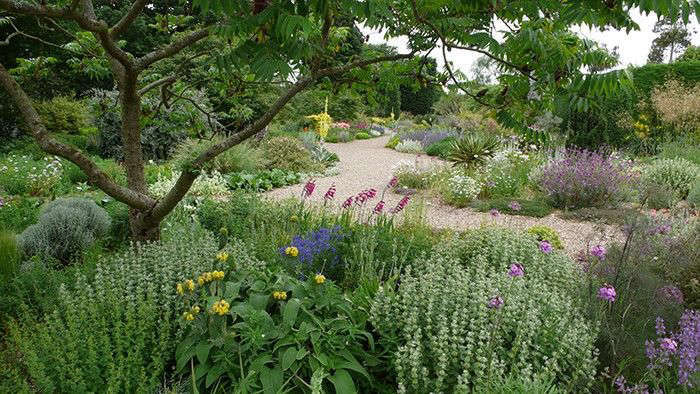
Photography by Clare Coulson.
Beth Chatto’s gardens in the driest part of the United Kingdom (with just 20 inches of annual rainfall) have become famous not only for their sheer beauty, but also for the mantra on which Chatto’s nursery and entire gardening philosophy is based: right plant, right place.
And to prove her point, almost 25 years ago she planted a new gravel garden on what was once the car park of her home, nursery, and gardens in Elmstead, Essex.
Soil Prep: Double Digging
Bergenias, says Ward, are an indispensable part of the plant list, providing lush foliage in summer and, with this variety B. ‘Miss Crawford’ (pictured in the foreground), white flowers appear in late winter when little else is in flower.
But that’s not to say that there’s not a good layer of topsoil now; when planting new areas the ground is double dug to a depth of two spits and this is especially important on compacted soil.
The beds are all designed with serpentine curves and the best way to mark them out is with an obliging garden hose to create smooth lines.
Design: Soft Edges
The gravel garden is never watered or fed, so soil preparation and planting is key.
Plant Prep: Hydrate
Beth has an incredible eye, which is evident in every corner of her gardens. Often there are triangles within larger triangles.
Planting Scheme: Triangles
Garden Design: Texture
Texture is another key component, contrasting spiky shapes with softer textures or pretty colors.
Accents of purples and yellows bring a cohesion, often dotted through in a considered way, drawing the eye through the space.
Color Palette: Purple and Yellow
Color Palette: Pastel Pinks
There is a surprising number of soft pastel shades too, with alstromeria and annual poppies in pale pink to self-seed throughout the garden.
Almost everything in the gravel garden is hardy – the exception is the agaves which are planted out in early June once the threat of frosts has passed, creating silver focal points.
Foliage Focal Points
Foliage is critical in all shades of green from the soft silvers of Stachys byzantina, Melianthus major, sea kale, and santolinas to the many varieties of thyme and marjoram that creep around the front of the borders or create lush mounds that have the added benefit of wonderful scent too.
Shades of Green
Self-Seeding: Be Selective
The off-spring of rampant self-seeders are often removed before they dominate.
Many perennials including phlox, gaura, and sedums are cut back in late May to extend the season and, in some cases, to stop them getting too tall.
Deadheading: Extend the Season
: The next gravel garden study day with David Ward will be September 21.